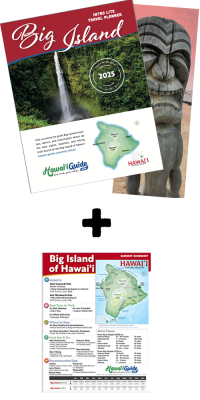Big Island of Hawaii Visitor Center
Macadamia Nuts
Mauna Loa Macadamia Nut Plantation invites visitors to witness the growing, harvesting and processing of Mauna Loa Macadamia Nuts into many Mauna Loa products. Hundreds of rows of macadamia nut trees line Macadamia Road on the 3-mile drive leading to the visitor center and processing plant. Visitors can view the plant where the nuts are husked and dried. An array of macadamia nut products are created and processed here and are available for purchase directly from the shop.

Mauna Loa harvests some 35 million pounds of macadamia nuts a year for use in cooking, making confections, and for sale to the public at visitor centers and stores throughout Hawai`i and internationally. The mature macadamia nut trees create wonderful shade with their dark green foliage and white, raceme blossoms in Winter and Spring. The main harvest is in Summer and Fall.
In 1881, the first macadamia tree was brought to Hawaii from Australia, and the first pioneer plantation began in 1921. It was in 1922 that the University of Hawaii embarked on 20 years of testing and research. Some 60,000 trees were observed and tested in a painstaking process of selection and grafting. Eventually, nine strains were developed that could consistently produce a high-quality nut. That was the beginning of a long partnership between MAUNA LOA and the University of Hawaii, which continues today.
The original plantation of what was to become Mauna Loa Macadamia Nut Corporation was established in 1946. The very first macadamia nut trees were planted early that year near Kea'au on the Big Island of Hawaii, where that plantation continues to thrive today.
In 1956, the first commercial crop was harvested. Macadamia trees take seven years to produce a commercial crop and 15 years before they a producing consistently. By 1976, the sugar plantation business in Hawaii was waning. Mauna Loa Macadamia Nut Corporation began converting five old sugar plantations to macadamia plantations at the rate of 1000 acres a year. Most of those trees are still producing the premium macadamia nuts that they use to produce the commercial nuts today.

Mauna Loa Macadamia Nut Corporation reduces its carbon footprint by burning macadamia husks, shells, and waste kernel to generate the energy required to power its Hilo processing facility. This renewable biofuel accounts for 60% of the facility's electricity usage; greatly reducing Mauna Loa's reliance on oil produced energy.
Mauna Loa has also reduced its overall reliance on electrical energy by channeling the generated steam to heat the factory's nut drying tanks. Also, to further reduce reliance on non-organic fertilizer, waste macadamia husks are composted and returned as organic fertilizer to the orchards.
"We live in such special and delicate surroundings that we sometimes take it for granted. It is surreal to see volcanoes and lush forests every day and we easily forget how privileged we are or the responsibility we all have in preserving and protecting our environment," stated Charles Young, Plant Manager at Mauna Loa Macadamia Nut Corporation.
Including 1.5 ounces of macadamia nuts, each day may lead to an improvement in blood cholesterol levels, according to a study funded by The Hershey Company (NYSE: HSY). Macadamia nuts are a concentrated source of monounsaturated fat, which, when eaten regularly may help displace sources of cholesterol-raising saturated fats in the diet, however, the data indicate there may be other healthful compounds in macadamia nuts. The reductions in blood cholesterol with the macadamia nut diet are greater than what would be expected solely on the basis of the type of fat consumed, suggesting that there are other bioactive factors in macadamia nuts.
The Mauna Loa Macadamia Nut Visitor Center is located on a plantation on Macadamia Road off Highway 11 between Hilo and Volcanoes National Park.
FREE 2025 DOWNLOADS
Big Island Intro Visitor Guide
+ Our Summary Guidesheet!
Includes the top must-see & do attractions, best times to visit, a monthly weather & visitor summary, and our tips on how to save when booking your car rental, tours, and activities. Plus, grab our free Big Island Summary Guidesheets.



